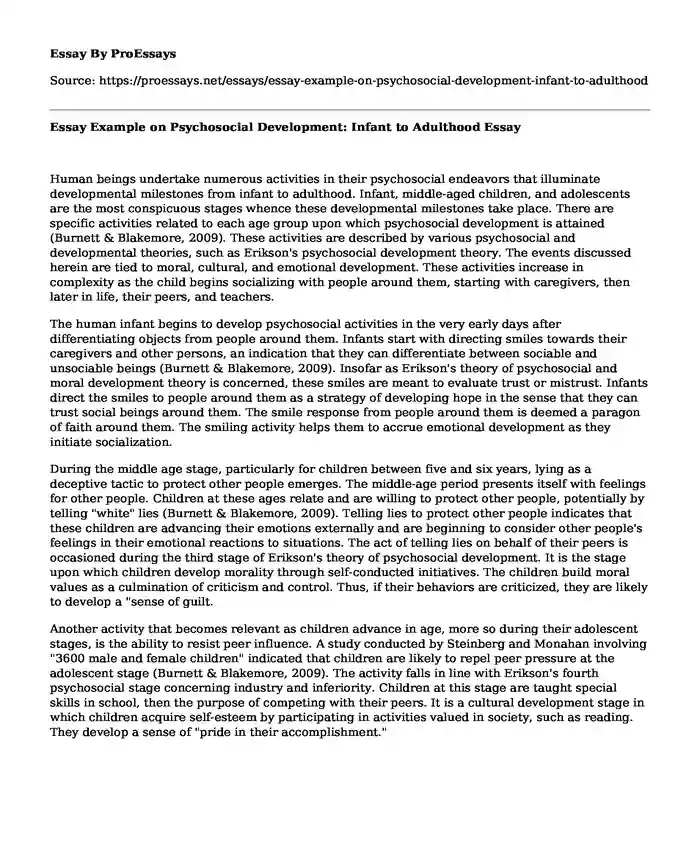Human beings undertake numerous activities in their psychosocial endeavors that illuminate developmental milestones from infant to adulthood. Infant, middle-aged children, and adolescents are the most conspicuous stages whence these developmental milestones take place. There are specific activities related to each age group upon which psychosocial development is attained (Burnett & Blakemore, 2009). These activities are described by various psychosocial and developmental theories, such as Erikson's psychosocial development theory. The events discussed herein are tied to moral, cultural, and emotional development. These activities increase in complexity as the child begins socializing with people around them, starting with caregivers, then later in life, their peers, and teachers.
The human infant begins to develop psychosocial activities in the very early days after differentiating objects from people around them. Infants start with directing smiles towards their caregivers and other persons, an indication that they can differentiate between sociable and unsociable beings (Burnett & Blakemore, 2009). Insofar as Erikson's theory of psychosocial and moral development theory is concerned, these smiles are meant to evaluate trust or mistrust. Infants direct the smiles to people around them as a strategy of developing hope in the sense that they can trust social beings around them. The smile response from people around them is deemed a paragon of faith around them. The smiling activity helps them to accrue emotional development as they initiate socialization.
During the middle age stage, particularly for children between five and six years, lying as a deceptive tactic to protect other people emerges. The middle-age period presents itself with feelings for other people. Children at these ages relate and are willing to protect other people, potentially by telling "white" lies (Burnett & Blakemore, 2009). Telling lies to protect other people indicates that these children are advancing their emotions externally and are beginning to consider other people's feelings in their emotional reactions to situations. The act of telling lies on behalf of their peers is occasioned during the third stage of Erikson's theory of psychosocial development. It is the stage upon which children develop morality through self-conducted initiatives. The children build moral values as a culmination of criticism and control. Thus, if their behaviors are criticized, they are likely to develop a "sense of guilt.
Another activity that becomes relevant as children advance in age, more so during their adolescent stages, is the ability to resist peer influence. A study conducted by Steinberg and Monahan involving "3600 male and female children" indicated that children are likely to repel peer pressure at the adolescent stage (Burnett & Blakemore, 2009). The activity falls in line with Erikson's fourth psychosocial stage concerning industry and inferiority. Children at this stage are taught special skills in school, then the purpose of competing with their peers. It is a cultural development stage in which children acquire self-esteem by participating in activities valued in society, such as reading. They develop a sense of "pride in their accomplishment."
Conclusion
In conclusion, psychosocial activities and behaviors are developed through a process that starts at the infant stages of one's life. The process is imbued with age-specific activities that could be explained and validated by existing psychosocial development theories. During the infant stage, indeed, the first stage, smiling, is one of the most notable activities. They smile to enhance trust with their caregivers or people around them. The second activity that is associated with children in the middle age is lying. At the middle age stage, children begin to lie on behalf of their peers, illuminating their connectedness with others' emotions. The other critical stage of psychosocial development is the adolescent stage. Children at this stage are noted to display a peer repulsion characteristic as they develop various special skills. They repel peer pressure by seeking personal excellence and accomplishment.
Reference
Burnett, S., & Blakemore, S.-J. (2009). The Development of Adolescent Social Cognition. Annals of the New York Academy of Sciences, 1167(1), 51–56. https://doi.org/10.1111/j.1749-6632.2009.04509.x
Cite this page
Essay Example on Psychosocial Development: Infant to Adulthood. (2023, Sep 21). Retrieved from https://proessays.net/essays/essay-example-on-psychosocial-development-infant-to-adulthood
If you are the original author of this essay and no longer wish to have it published on the ProEssays website, please click below to request its removal:
- Analysis of the Biblical Text Essay
- Social Construction of Power: Research Proposal
- Essay Example on Motivating Human Needs: Maslow's Theory
- Essay Sample on Courteous Civility in Society: Exploring Kindness & Incivility
- Essay Example on My Childhood Experience: Determining My Future
- Essay Example on Education: The Backbone for Achieving Success in Life
- Gender Theory - Free Essay Sample







